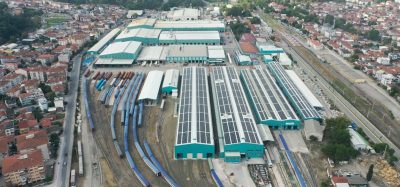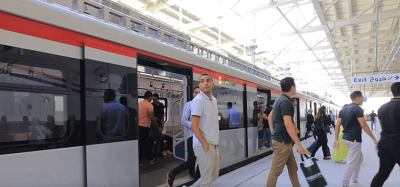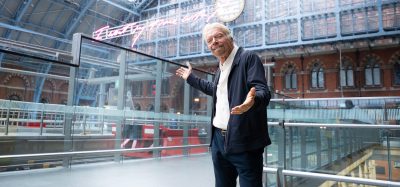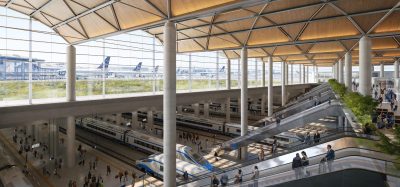Norwegian railways enter a year of intensive planning
Posted: 8 June 2012 | | No comments yet
Since the beginning of 2012, three important reports on Norwegian railways have been issued in quick succession. First was the major high-speed study, followed by Jernbaneverket’s concept study for expansion of the InterCity network in eastern Norway. Subsequently, the central government agencies for sea, air, road and rail transport tabled their proposals for a new National Transport Plan (NTP) covering the period 2014-23.
The high-speed study examines options for the future of the rail network and recommends long-term strategies for developing longdistance passenger rail services on the main routes in the southern part of Norway: Oslo-Trondheim, Oslo-Bergen, Oslo-Stavanger and Bergen-Haugesund-Stavanger, plus the Oslo-Gothenburg and Oslo-Stockholm cross-border routes. The InterCity study is intended to establish a timeline and a cost estimate for comprehensive expansion of the InterCity network. The report proposes construction of double-track lines for speeds of up to 250km/h on the Oslo-Halden, Oslo-Larvik and Oslo-Lillehammer routes. In this way, the InterCity routes will be upgraded for future high-speed trains.
Since the beginning of 2012, three important reports on Norwegian railways have been issued in quick succession. First was the major high-speed study, followed by Jernbaneverket’s concept study for expansion of the InterCity network in eastern Norway. Subsequently, the central government agencies for sea, air, road and rail transport tabled their proposals for a new National Transport Plan (NTP) covering the period 2014-23. The high-speed study examines options for the future of the rail network and recommends long-term strategies for developing longdistance passenger rail services on the main routes in the southern part of Norway: Oslo-Trondheim, Oslo-Bergen, Oslo-Stavanger and Bergen-Haugesund-Stavanger, plus the Oslo-Gothenburg and Oslo-Stockholm cross-border routes. The InterCity study is intended to establish a timeline and a cost estimate for comprehensive expansion of the InterCity network. The report proposes construction of double-track lines for speeds of up to 250km/h on the Oslo-Halden, Oslo-Larvik and Oslo-Lillehammer routes. In this way, the InterCity routes will be upgraded for future high-speed trains.
Since the beginning of 2012, three important reports on Norwegian railways have been issued in quick succession. First was the major high-speed study, followed by Jernbaneverket’s concept study for expansion of the InterCity network in eastern Norway. Subsequently, the central government agencies for sea, air, road and rail transport tabled their proposals for a new National Transport Plan (NTP) covering the period 2014-23.
The high-speed study examines options for the future of the rail network and recommends long-term strategies for developing longdistance passenger rail services on the main routes in the southern part of Norway: Oslo-Trondheim, Oslo-Bergen, Oslo-Stavanger and Bergen-Haugesund-Stavanger, plus the Oslo-Gothenburg and Oslo-Stockholm cross-border routes. The InterCity study is intended to establish a timeline and a cost estimate for comprehensive expansion of the InterCity network. The report proposes construction of double-track lines for speeds of up to 250km/h on the Oslo-Halden, Oslo-Larvik and Oslo-Lillehammer routes. In this way, the InterCity routes will be upgraded for future high-speed trains.
Important report
Late-2011 saw the publication of another important report on the main challenges facing Norwegian railways, which emphasised the need to establish targets for rail’s role in the transport system and strategies for achieving those targets over a 20-40-year period. The report was commissioned by the Minister of Transport, and the Working Group, led by the permanent secretary at the Ministry of Transport and Communications, included the chief executives of the major players in the Norwegian rail sector and a representative of the transport and logistics industry.
Join our free webinar: Rail cyber-security in a time of technological and regulatory transformation
Join our expert panel, including speakers from Nokia and Siemens Mobility, to explore the critical convergence of cybersecurity and 5G rail comms.
Date: 3 Dec | Time: 15:00 GMT
Can’t attend live? No worries – register to receive the recording post-event.
Faster completion
We emphasised that the planning and construction of new rail capacity needs to be completed faster and for longer sections at a time. Clear targets and binding decisions at an early stage regarding project implementation and required progress may result in more efficient planning processes. Larger and more predictable funding allocations are also needed. We suggested that alternative funding sources, funding arrangements and project organisational structures should be examined, preferably in connection with specific rail projects.
New transport plan
In its input to the new National Transport Plan, Jernbaneverket, like the other national transport agencies, has set out the main challenges that the Norwegian society faces in addressing the increased demand for transport resulting from population increases and economic growth. Norway’s population recently passed the five million mark and is forecast to reach six million in the next 11 years, with the biggest growth occurring in the InterCity region. Rail has an important role to play, both by accommodating higher freight volumes and by transporting people efficiently to and from their workplaces. However, this will require large amounts of expenditure. The political debate promises to be exciting. We expect to receive many of the answers when the government presents its proposed National Transport Plan 2014-23 to parliament in the spring of 2013.
Greater needs
Operation, maintenance and renewal are the top priorities in our proposals for the new National Transport Plan. This was the case with the current plan too, but the needs have proved to be even greater than we estimated at the time it was prepared. Jernbaneverket also intends to embark on a large-scale renewal of signalling systems, for which NOK 7-8 million is set aside in the renewal budget over the next decade.
More rail freight
Reliability is key if rail freight traffic is to increase in Norway. The scope for expansion is also limited at present by low capacity on several of the main lines and especially at terminals. In order to meet the objective of doubling rail freight capacity, Jernbaneverket is giving priority to its ongoing programme to construct passing loops long enough to accommodate 600m trains on the main lines. Alnabru yard in Oslo is to be expanded with a new terminal, and terminal capacity in Trondheim and Bergen will be increased within the existing footprint until it proves necessary to build new terminals. Other priorities are increased capacity for iron ore traffic on the Ofoten line and for timber traffic.
Rail as the backbone
On the passenger side, Jernbaneverket is giving priority to investment in the InterCity region and around the major urban centres. The transport demand resulting from the large growth in urban populations, especially in the Østland region (eastern Norway), can only be met by a comprehensive public transport network. Today’s railway has a key role to play as the backbone of the public transport system. By focusing on developing a modern, doubletrack network on the InterCity routes, we can substantially reduce the travel time between cities and connect the entire Østland region into a single travel-to-work area.
Comprehensive upgrading
Jernbaneverket wishes to see a comprehensive upgrading of the InterCity routes. In the course of the study, we determined that the full InterCity network could be constructed in 10 years, with 13 years as the optimum time – frame. The upgrading will cost approximately NOK 130 billion in total, which would require a 136% increase in the capital budget if it were to be completed in 10 years. Comprehensive upgrading of the InterCity network will require a completely different form of funding than the current arrangement, whereby the railway’s capital budget is set annually by parliament as part of the national budget.
Detailed high-speed study
Over the past two years, a detailed and substantive study was conducted of the future options for high-speed rail in Norway. It was important to us that all the stakeholders should be able to have confidence in the technical findings. The high-speed debate has been typified by bold assertions and convictions held with an almost religious fervour. The study was conducted by leading industry experts from Norway and abroad, ensuring a good mix of local knowledge and high-speed expertise. After the report was published, commentators were unanimous in their opinion that the authors had done a fine job. Whatever one may think of high-speed rail, we now have a solid basis for decision making.
‘Viable’ high-speed rail
The high-speed study showed that high-speed rail in Norway may be viable in business terms if we exclude the costs of new infrastructure from the equation. In other words, high-speed rail is not socioeconomically viable. However, a highspeed network serving the main urban centres in the south of Norway could create a ripple effect in the form of significant economic benefits for the region. The environmental benefits are not as big as we had thought, since the actual construction work will produce large CO2 emissions. Last but not least, the cost of a full upgrade would be almost NOK 1 trillion.
InterCity first
Another priority for the high-speed study was to make it clear that investment in the InterCity routes in the Østland region does not preclude development of a high-speed network linking the main cities in the south of Norway. We have been successful in this area too, since there seems to be broad consensus among politicians that capital expenditure priority number 1 is the InterCity network and improvements around other urban centres. Subsequently, an improved long-distance offering will evolve based on the solutions already put in place to accommodate daily commuter travel.
Critical debate
It is now time for political debate in Norway as to where rail spending should be targeted, what role rail should play in future, and how large-scale development of the rail network should be structured and financed. This debate will be of critical importance, since rail is currently in need of a major boost, predictable operating parameters, and clarification of the role it is expected to play in the long-term. The recently published reports provide a thorough analysis and a good basis for this critically important debate.
Maintenance and renewal
While discussions continue regarding the future, the most important task is to provide a rail system people can rely on in the short-term. For this reason, ongoing maintenance and renewal of the existing infrastructure will remain Jernbaneverket’s top priority in allo – cating its resources. This view is reflected in our input to the new National Transport Plan. The major enhancements to the rail system now under discussion will require completely different parameters and funding arrangements than we currently have. This too is a crucial component in the debate.
Briefing
National Transport Plan
The National Transport Plan (NTP) sets out the main features of the Norwegian Government’s transport policy and provides a basis for wellrounded political decision-making, efficient use of policy instruments, and improved interaction between transport modes. The plan is adopted by parliament for a 10-year period but is revised every four years. The current NTP, passed in 2009, covers the years 2010-19.
The central government agencies for road, rail, maritime transport and civil aviation first draw up a basis for planning, based on guidelines issued by the Ministry of Transport and Communications and the Ministry of Fisheries and Coastal Affairs. This proposal is submitted to the Ministry of Transport and Communications, which then formulates the government’s draft National Transport Plan for presentation to parliament.
A new NTP for the period 2014-23 will be presented to parliament in spring 2013.
Norway’s InterCity network
The InterCity network is defined as the routes from Oslo to Lillehammer, Halden and Skien. The largest proportion of passengers on these routes are commuters, mainly heading into greater Oslo. The current InterCity strategy from the early 1990s states that the demand for passenger rail transport in this region is best met with a level of service that requires a consistently modern, double-track rail network.
After this strategy was adopted, a few sections were double-tracked, but most of the network remains single-track. The curvature, which may have been adequate a century ago, now necessitates low speeds compared with both potential rail speeds and the speeds possible on the roads. The high proportion of single-track route mileage means many holdups and a lack of flexibility. The challenge, besides resource-intensive operation and maintenance, is that there is insufficient capacity to meet the demand for improved services in the form of more trains, shorter journey times and better timekeeping.
About the author
Elisabeth Enger has been Director General of Jernbaneverket since August 2008. Ms. Enger has vast experience of the public sector in Norway. She was an administrative officer in Akershus County Municipality from 1980 to 1982, and then a consultant and later Chief Administrative Officer in the municipality Skodje from 1983 to 1989. She then worked as a Director in the Norwegian Association of Local and Regional Authorities. She returned as Chief Administrative Officer in Lier from 1994 to 2001 and Bærum from 2001 to 2008. Elisabeth Enger has a bachelor’s degree in Law and Public Administration.
OUT NOW: The Definitive Guide to Rail’s Digital Future
The rail industry is undergoing a digital revolution, and you need to be ready. We have released our latest market report, “Track Insight: Digitalisation.”
This is not just another report; it’s your comprehensive guide to understanding and leveraging the profound technological shifts reshaping our industry. We move beyond the buzzwords to show you the tangible realities of AI, IoT, and advanced data analytics in rail.
Discover how to:
- Optimise operations and maintenance with real-time insights.
- Enhance passenger services through seamless, high-speed connectivity.
- Leverage technologies like LEO satellites to improve safety and efficiency.
Featuring expert analysis from leaders at Nomad Digital, Lucchini RS, Bentley Systems and more, this is a must-read for any rail professional.
Issue
Related topics
Cargo, Freight & Heavy-Haul, High-Speed Rail, Route Development, Track/Infrastructure Maintenance & Engineering







